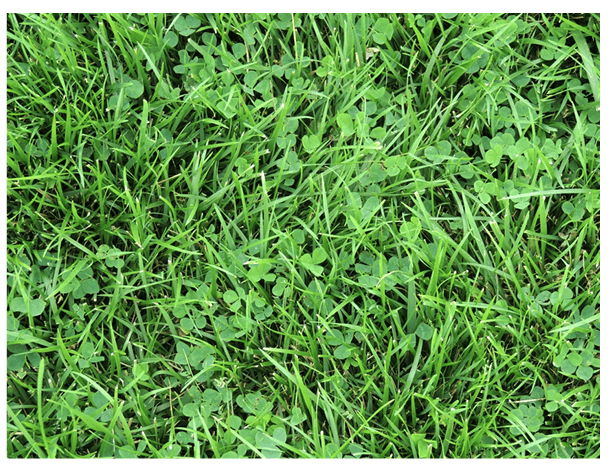White clover or Dutch white clover (Trifolium repens) is a perennial plant, native to Europe, which often shows up in lawns by way of seed dispersal. All clovers are legumes. Through a symbiotic relationship with Rhizobium soil bacteria, legumes are able to transform atmospheric nitrogen gas into an organic form of nitrogen that can be used by plants. Prior to the introduction of broadleaf herbicides in the 1950s, clover was a valued component of lawn seed mixtures for its ability to fix nitrogen, enrich the soil, and improve turfgrass growth. Clover adds diversity to lawns and provides food for bees.
Microclover refers to smaller varieties of white clover (Trifolium repens var. ‘Pirouette’ and ‘Pipolina’). These types have smaller leaves, fewer flowers, and a lower growth habit compared to Dutch white clover. They also have a less aggressive clump-forming habit. Because of these characteristics and their nitrogen-fixing ability, there is interest in using microclover in lawns to enhance turfgrass growth and reduce nitrogen fertilizer applications. Limiting nitrogen runoff is a goal of the Maryland Lawn Fertilizer Law as part of broader efforts to protect the Chesapeake Bay.
The University of Maryland conducted research on microclover used in combination with turf-type tall fescue. There are advantages and disadvantages to its use:
Advantages of microclover
- Mixes well with turf-type tall fescue (and Kentucky bluegrass) and provides a uniform appearance;
- Provides an organic source of nitrogen (in grass clippings and as it decays) to support turfgrass growth; may reduce one nitrogen application per year;
- Flowers provide a food source for bees.
Disadvantages of microclover
- Does not tolerate high heat and drought; starts to die when cool-season turfgrass enters dormancy in the summer; requires reseeding for persistence;
- Top growth dies back in the winter which can leave bare spots and lead to erosion;
- Poor shade tolerance;
- Seeds are expensive and not readily available in retail stores;
- Most broadleaf herbicides labeled for use on tall-fescue will kill microclover;
- Bees attracted to the flowers may be undesirable for people with bee sting allergies;
- Southern blight disease can be a problem occasionally in prolonged periods of high humidity and high nighttime temperatures.
Microclover can be included as a component of lawns, but there is no current research that supports its successful use exclusively as a groundcover or lawn alternative in Maryland.
Additional resources
(PDF) Microclover - Tall Fescue Lawns in the Mid-Atlantic Region, University of Maryland Turfgrass Technical Update, 2015.
Q&A: Pros and Cons of the No-Mow May Movement (addresses the use of clover in lawns) | Maryland Grows Blog
By Christa Carignan, Maryland Certified Professional Horticulturist, Coordinator, University of Maryland Extension Home & Garden Information Center. Reviewed by Dr. Mark J. Carroll, Director, Environmental Science & Policy Program, University of Maryland, April 2019.
Still have a question? Contact us at Ask Extension.
 English
English العربية
العربية Български
Български 简体中文
简体中文 繁體中文
繁體中文 Hrvatski
Hrvatski Čeština
Čeština Dansk
Dansk Nederlands
Nederlands Suomi
Suomi Français
Français Deutsch
Deutsch Ελληνικά
Ελληνικά हिन्दी
हिन्दी Italiano
Italiano 日本語
日本語 한국어
한국어 Norsk bokmål
Norsk bokmål Polski
Polski Português
Português Română
Română Русский
Русский Español
Español Svenska
Svenska Català
Català Filipino
Filipino עִבְרִית
עִבְרִית Bahasa Indonesia
Bahasa Indonesia Latviešu valoda
Latviešu valoda Lietuvių kalba
Lietuvių kalba Српски језик
Српски језик Slovenčina
Slovenčina Slovenščina
Slovenščina Українська
Українська Tiếng Việt
Tiếng Việt Shqip
Shqip Eesti
Eesti Galego
Galego Magyar
Magyar Maltese
Maltese ไทย
ไทย Türkçe
Türkçe فارسی
فارسی Afrikaans
Afrikaans Bahasa Melayu
Bahasa Melayu Kiswahili
Kiswahili Gaeilge
Gaeilge Cymraeg
Cymraeg Беларуская мова
Беларуская мова Íslenska
Íslenska Македонски јазик
Македонски јазик יידיש
יידיש Հայերեն
Հայերեն Azərbaycan dili
Azərbaycan dili Euskara
Euskara ქართული
ქართული Kreyol ayisyen
Kreyol ayisyen اردو
اردو বাংলা
বাংলা Bosanski
Bosanski Cebuano
Cebuano Esperanto
Esperanto ગુજરાતી
ગુજરાતી Harshen Hausa
Harshen Hausa Hmong
Hmong Igbo
Igbo Basa Jawa
Basa Jawa ಕನ್ನಡ
ಕನ್ನಡ ភាសាខ្មែរ
ភាសាខ្មែរ ພາສາລາວ
ພາສາລາວ Latin
Latin Te Reo Māori
Te Reo Māori मराठी
मराठी Монгол
Монгол नेपाली
नेपाली ਪੰਜਾਬੀ
ਪੰਜਾਬੀ Afsoomaali
Afsoomaali தமிழ்
தமிழ் తెలుగు
తెలుగు Yorùbá
Yorùbá Zulu
Zulu ဗမာစာ
ဗမာစာ Chichewa
Chichewa Қазақ тілі
Қазақ тілі Malagasy
Malagasy മലയാളം
മലയാളം සිංහල
සිංහල Sesotho
Sesotho Basa Sunda
Basa Sunda Тоҷикӣ
Тоҷикӣ O‘zbekcha
O‘zbekcha አማርኛ
አማርኛ Corsu
Corsu Ōlelo Hawaiʻi
Ōlelo Hawaiʻi كوردی
كوردی Кыргызча
Кыргызча Lëtzebuergesch
Lëtzebuergesch پښتو
پښتو Samoan
Samoan Gàidhlig
Gàidhlig Shona
Shona سنڌي
سنڌي Frysk
Frysk isiXhosa
isiXhosa